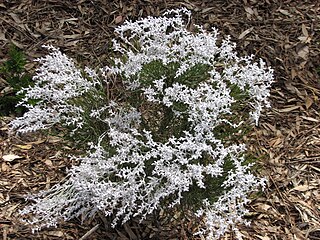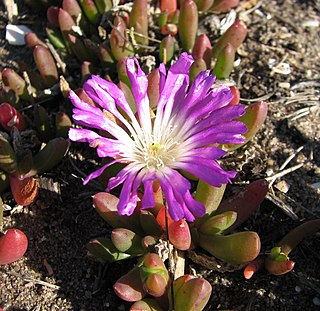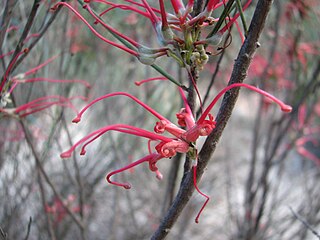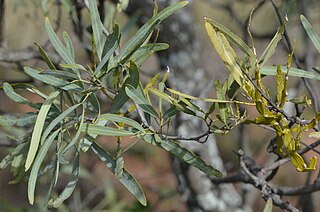
Ozothamnus is a genus of plants found in Australia, New Zealand and New Caledonia.

Banksia nobilis, commonly known as the golden dryandra, great dryandra or kerosene bush, is a shrub of the family Proteaceae which is endemic to Western Australia. It occurs on lateritic rises from Eneabba to Katanning in the state's Southwest Botanic Province. With large pinnatifid leaves with triangular lobes, and a golden or reddish pink inflorescence, it is a popular garden plant. It was known as Dryandra nobilis until 2007, when all Dryandra species were transferred to Banksia by Austin Mast and Kevin Thiele. There are two subspecies, B. nobilis subsp. nobilis and B. nobilis subsp. fragrans.
Conospermum acerosum, commonly known as needle-leaved smokebush, is a shrub endemic to Western Australia

Conospermum stoechadis, commonly known as common smokebush, is a shrub endemic to Western Australia.
Conospermum stoechadis subsp. sclerophyllum is a shrub endemic to Western Australia.

Grevillea manglesii is a shrub which is endemic to an area around Perth in Western Australia. It usually grows to around 3 metres in height and 4 metres in width and produces white flowers throughout the year.
Chthonocephalus is a genus of annual herbs in the family Asteraceae. The genus is endemic to Australia, with species occurring in all mainland states.

Grevillea rhyolitica, also known as Deua grevillea, is a shrub which is endemic to south-eastern New South Wales in Australia. It grows to between 0.5 and 2 metres in height.

Disphyma crassifolium subsp. clavellatum is the subspecies of Disphyma crassifolium that occurs in Australia and New Zealand. It is sometimes known by the common name rounded noon-flower
Atriplex paludosa subsp. baudinii is subspecies of Atriplex paludosa that is endemic to Western Australia.

Banksia laevigata subsp. fuscolutea is a subspecies of Banksia laevigata. It is native to the Southwest Botanical Province of Western Australia.
Banksia meisneri subsp. ascendens, commonly known as Scott River banksia, is a subspecies of Banksia meisneri. It is native to the Southwest Botanical Province of Western Australia.
Banksia splendida subsp. splendida is a subspecies of Banksia splendida. It was known as Dryandra speciosa subsp. speciosa until 2007, when Austin Mast and Kevin Thiele sunk all Dryandra into Banksia. Since the name Banksia speciosa had already been used, Mast and Thiele had to choose a new specific epithet for D. speciosa and hence for this subspecies of it. As with other members of Banksia ser. Dryandra, it is endemic to the South West Botanical Province of Western Australia. As an autonym, it is defined as encompassing the type material of the species.
Banksia meisneri subsp. meisneri is a subspecies of Banksia meisneri. It is native to the Southwest Botanical Province of Western Australia. As an autonym, it is defined as containing the type specimen of the species.
Nicotiana occidentalis subsp. hesperis is a short-lived herb native to Australia.

Erodium cygnorum is a species of herb native to Australia.

Grevillea sarissa, the wheel grevillea, is a shrub which is native to South Australia and Western Australia. It grows to between 0.6 and 3.5 metres in height and produces yellow, red or pink flowers between August and December in its native range.

Adenanthos pungens, the spiky adenanthos, is a species of shrub in the family Proteaceae. It is endemic to the south-west of Western Australia.

Grevillea ramosissima, commonly known as fan grevillea, is a shrub species of the family Proteaceae. It is native to south-eastern Australia.

Korthalsella rubra is a flowering plant in the Santalaceae (sandalwood) family, formerly placed in the Viscaceae.











